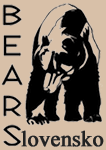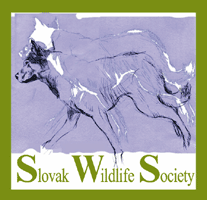

Census of bears in Malá Fatra NP
On 29th June – 1st July 2007 we took part in a census of bears in Malá Fatra together with cameraman Rasťo Dobrovodský, which was organised by Malá Fatra National Park administration. We were divided into pairs and assigned to separate locations where bears were expected to occur, where we were to observe with the help of binoculars or a spotting scope during the course of 3 days. With Rasťo we arrived at our assigned section, Steny, on Friday evening. That day and the following morning we saw many red deer on both sides of the main ridge, including groups of hinds with fawns as well as small herds of stags, but no bears. After a cold night spent in sleeping bags on the ridge we therefore decided to move lower down the hillside.
As soon as we got near the upper timber line we started to find signs of bear presence (faeces, diggings). We were surprised to see bilberries already ripe. We chose a suitable spot with a good view, set up our shelter and waited to see if a bear would appear. During the day and in the evening we saw red deer alternately grazing and resting. Just before dark Rasťo excitedly declared, "Bear!" Quickly, we took our binoculars and focussed on something dark and large that was digging in the ground at the forest edge. A little disappointedly we found that it was a wild boar. Shortly afterwards a beautiful full moon rose, but our imaginings of night-time viewing by moonlight were ended when it soon disappeared into cloud. So ended our second day of observation.



Next morning we again got up before the sun and checked our nearby surroundings and the more distant slopes. "Our" wild boar was there again; it had changed location only slightly during the night. The calm atmosphere of grazing herbivores was suddenly broken by the braying of a startled roe deer: right behind him was a lynx! We watched the magnificent animal hunting. When it had not managed to catch its prey after 3 attempts it calmly lay down and began to clean its paws with its tongue.
After another couple of hours, as the ridge above us began to fill up with tourists, we resigned ourselves to the thought that we would not see a bear this time. We began to pack up. We were just about to leave when with a hushed voice Rasťo again declared, "Bear!" And this time it really was. It came out of the forest about 100 metres below us, its beautiful light-tipped fur making it resemble a grizzly. It was not aware of us: probably it was not expecting there to be any people in the area. It dug something out from under a rock and then began to feed on bilberries. Rasťo filmed it for several minutes before it was lost from view in a gully. Carefully I traversed the slope parallel to the bear and again it came into view. The bear noticed me when I was about 70m away. For a moment we looked at each other and each wondered what to do next. I stood still and the bear ran off unhurriedly about 50-100m then stopped and looked back over its shoulder at me suspiciously to see what I was doing. When it felt out of danger it began feeding again.
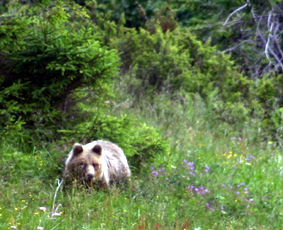
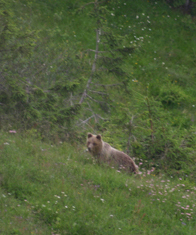
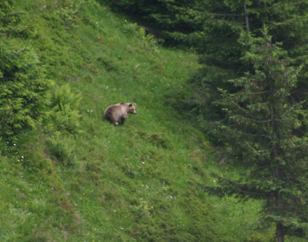
We watched the bear from 10.30 until 14.30, during which time it did not stop eating and it was still there when we had to leave. Presumably it was active during the day because, besides us, there were no people in the locality. The whole time we could hear the voices of tourists on the main ridge about 700m away from us, unaware of the bear. The bear presumably knew from past experience that tourists in the area use only the main ridge and so it was not disturbed in its activities.
We wrote up our observations on the census form and I went back to the place where we had first seen the bear in order to get samples for research. Then, our thoughts full of beautiful experiences and the feeling of a job well done, we set off home. For us this 3-day trip had added value because together with Rasťo and his brother Roman we are preparing a film in which the footage we obtained will be used.
According to Michal Kalaš of Malá Fatra National Park administration, a total of 11 different bears were identified during this census but "ours" was the only one documented with photographs. Most bears were seen in the evening of the first day. The results of the census were limited due to an insufficient number of participants: observers were present at only 16 of 51 planned locations. Although there seemed to be several large individuals among those seen, it is not clear how reliably the size of the bears was estimated, because they were mostly spotted from a long way away. Interestingly, no females with cubs were observed, which indicates that the results should not be used to estimate the age-sex structure of the population.
Another census was carried out at the weekend of 15th-16th November. Conditions were not ideal due to heavy snow and very few people taking part, so little more can be said other than that some bears were still active. So exactly how many bears there are in Malá Fatra remains unknown.
